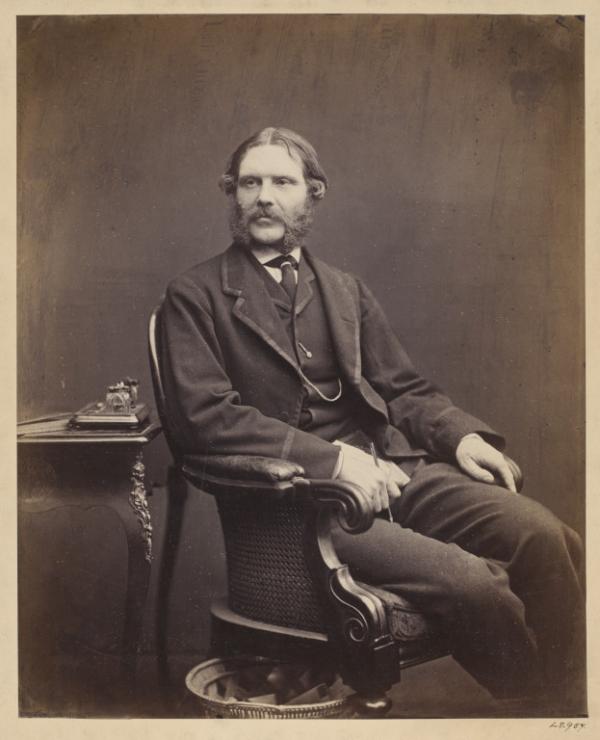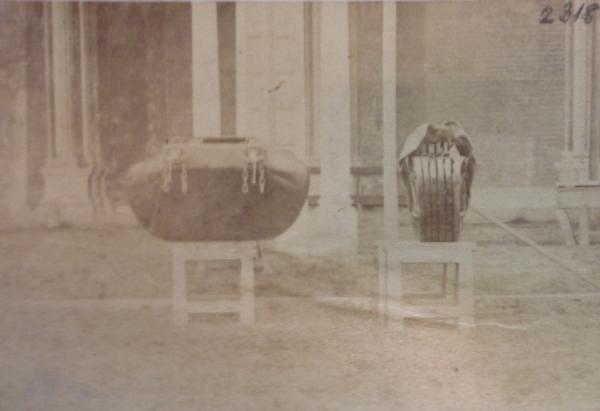As I was leafing through an early volume of the V&A Archive’s collection of Photographic Guardbooks the eclectic parade of historical treasures passing before me was suddenly interrupted by a seemingly incongruous gallery of Royal Engineers testing collapsible pontoons in the Museum grounds!

What possible reason could there be for pasting these photographs into the Guardbooks, I wondered? Time to do some digging.
Captain Francis Fowke (1823-65) was an architect with Department of Science and Art and responsible for designing the early galleries and courts erected at the South Kensington Museum between 1851 and 1865. His boss, Henry Cole (1808-82), described him as ‘a man of science, possessing a fertility of invention which amounted to genius’. Fowke’s inventions, which at times succeeded brilliantly in combining practicality with wackiness, included a military fire-engine, a folding camera, a portable India-rubber bath (an indispensable accoutrement for the discerning traveller!), a travelling scaffold (presumably for purposes of construction rather than delivery of capital punishment…) – and a collapsible military pontoon.

Fowke first exhibited his canvas pontoon at the 1855 Paris International Exhibition but it wasn’t until 1860 that testing began in earnest. On Friday 9 March Fowke delivered a lecture ‘On Military Pontoons, with suggestions for their improvement’ at the Royal United Service Institution. Henry Cole was sitting in the audience. The lecture was subsequently published in the Institute’s journal; its opening sentence – in spite of Fowke’s repeated assurances of brevity – suggests that Cole was in for a long evening…
“In reading this paper, it is not my intention to enter into any lengthened history, or to give any detailed explanation, of the principles or practice of military bridge-making or pontooning; but rather to discuss shortly and in a practical manner the merits and demerits of the system as now practised in the British service; and, as it is but unfruitful labour to stop at merely pointing out defects, I propose to introduce to you in as few words as possible a pontoon which I conceive is capable of remedying many, if not all, of the defects of the existing system.”
The lecture, however, seems not to have dulled Cole’s interest as he recorded in his diary on 25 June 1860: ‘Fowkes Pontoons tried on the Pond for the first time’. Cole probably refers here to the small pool (or water tank) in the Museum grounds.

Cole’s diary reveals that he was present at the Serpentine in Hyde Park on 2 July, where the pontoon bridge was given its first public demonstration. ‘Experiment very successful with Volunteers & Royal Engineers’, he wrote approvingly. A print – ‘Experiments with Captain Fowke’s pontoon bridge on the Serpentine, Hyde Park’ – was published in the Illustrated London News (11 August 1860).
This photograph shows the engineers rehearsing on dry land. Part of the Sheepshanks Gallery, which Fowke had designed in 1856, is visible in the top left corner.

Photographs in the Guardbook capture vividly the Encyclopedia Britannica’s description of Fowke’s pontoon design as ‘a folding open bateau, made of waterproof canvas attached to sliding ribs, so that for transport it could be collapsed like the bellows of an accordion and for use could be extended by a pair of stretchers’.


In 1861 Fowke sent to the War Office ‘documents and drawings explanatory of my canvas pontoons’, including 6 copies of his lecture and 4 sheets of photographs. He later arranged for the transport of a canvas boat and 6 pontoons to the Tower to be forwarded to the Military Storekeeper at Chatham.

It is unclear if Fowke’s pontoon design convinced the military authorities.
Fowke died suddenly on 4 December 1865. Inventive to the last, Cole eulogised before a gathering of the Society of Arts on 8 December 1865: ‘Captain Fowke, to my mind, was solving the problem of the decorative use of iron, and, by appreciating the spirit both of the Gothic and Renaissance architects, was on the threshold of introducing a novel style of architecture, when, alas! death, at the early age of 42 years, has cut short his promising career’.



